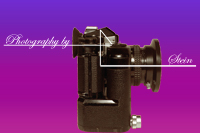I use Nikon bodies and lenses. Presently, I have one foot in each camp - the film camp, and the digital camp. All of the images were originally caught on 35mm film. Some of the earlier images were scanned into Photoshop Elements from the print, but now all of the images are scanned from the original negatives. They are then corrected (cropped, levels adjusted, aligned, hue and saturations tweaked, and sometimes unwanted clutter "erased") using Adobe Photoshop or Adobe Photoshop Elements on a Mac G4. For all those people I may have "erased" from my photos, I offer this blanket apology and explanation: I was too lazy or in too much of a hurry to obtain signed model release forms from all of you!
The fisheye images (click here for a good example of what I mean) - where seemingly straight lines at the edge of the photograph are curved - are taken using a Nikkor 16mm f/2.8 full-frame fisheye lens. For some, viewing fisheye photos is a matter of taste; some complain of vertigo when viewing these ultra-wide images. Others appreciate the artistic flair that the distortion provides. With practice, a photographer can accentuate or diminish the fisheye effect depending on the chosen perspective. I am drawn to the dramatic effect this lens can sometimes add to an otherwise ordinary photograph. This lens is not corrected for rectilinear distortion, hence the bending of straight lines as they approach the edges of the image. Even when an extreme fisheye effect is not desired, this lens enables a photographer to fit into spaces that a longer (hence, narrower angle of view) lens would not allow. The field of view for the fisheye lens is almost 180º wide, which means one needs to be careful not to include ones feet in the picture when the camera is vertically oriented.
The wide angle images (those with little or no rectilinear distortion) were taken with either a Nikkor Zoom 25-50mm f/4 or a Nikkor 20mm f3.5.
In terms of lighting, I try to avoid flash; available light seems to give a much more evenly-lit result. This goes especially for organ consoles, which when "flashed," tend to have hot spots where the flash is reflected most (sort of an organ console version of red-eye). Using flash to light large worship spaces is especially problematic, even with a powerful flash. The best results are obtained from lugging around a tripod and taking images using available light. If a tripod is not convenient, the one accessory always found in my camera bag is a trusty pumpkin bean-bag which makes for a convenient and mallable substitute.
I do thank my fellow former work-mates; many of these organs were photographed while I was in the employ of the Milnar Organ Company. While I did my best not to hold up work, my colleagues were quite patient with my getting "one more shot." The huge number of pipe organs this company maintains stretches from Bowling Green, KY to Montgomery, AL - and most of the points in between. They were (and still are) all great people to work for and to work with! You can see their site at milnarorgan.com
At least one of these photos are also being used for the site published by the Nashville Chapter of the American Guild of Organists. You can visit their site at nashvilleago.org I also have about 20 photos that are being used on the New York City organ project. You can link to that site at: nycago.org/Organs/NYC/index.html
All of the images on this site have all been taken by C. Kenneth Stein. I serve as full-time Director of Music and Organist at Belle Meade United Methodist Church, Nashville TN. Please be respectful of the time and effort the I have invested in these images. Please do not use these images without the consent of the photographer. If you would like to use any of these images, please ask first - I'm usually quite glad to have my photos appear on other sites, provided credit is given.
If you have any questions or comments about my photography, drop me a line....
And thank you for visiting my site!
